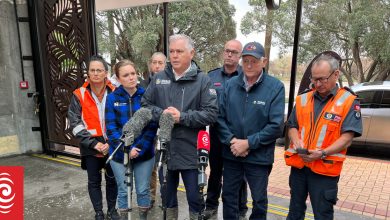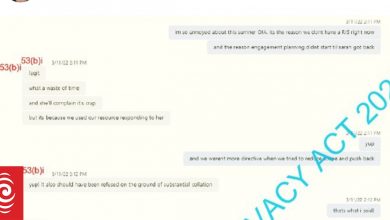Not just earthquakes: EQC gets a new name – the Natural Hazards Commission

Explainer – The Natural Hazards Commission Toka Tū Ake has taken over from the Earthquake Commission (EQC) with the goal of simplifying the process for claimants.
The new name comes after a law change last year aiming to make it easier and faster for residential homeowners to make a claim if their properties are damaged by a specified natural hazard.
The new legislation reflects the commission’s role to help prepare and recover from a range of natural hazards – earthquakes, tsunamis, landslips and floods.
“We cover more than just earthquakes,” commission chief executive Tina Mitchell said.
The government overhauled the legislation following reviews of EQC and a public inquiry released in 2020 that found it was poorly prepared for the Canterbury earthquakes.
Why are the changes necessary?
“It’s been a decade of change since the Canterbury earthquakes and with that we’ve had about 50 reviews as an organisation because the process in Canterbury was really tough for people,” Mitchell told Nine to Noon.
“The amount of financial cover was good but the process took a long time and was really stressful and frustrating.”
The government’s natural hazards insurance scheme, in place for nearly 80 years, provides baseline cover for damage to insured properties from a range of natural hazards.
Cover under the scheme remains largely the same under the new Act with some changes to clarify cover and entitlements.
The legislation creates a clearer process for claim excesses and calculations for retaining walls, bridges and culverts, Mitchell said.
Homeowners would also have increased cover for mixed-use buildings, such as apartments in commercial building.
Homeowners have access to the scheme if they have an insurance policy with fire cover. The premium paid to insurers includes a Natural Hazards Insurance Levy, which is the amount homeowners pay for this cover.
What are the key changes to the NHC?
One of the key changes for homeowners will be the ease with which they are able to make a claim.
Mitchell said after the Canterbury earthquakes anyone wanting to make a claim had to go through the EQC process which could take about a year, then they had to go back and start the process again with their private insurer. That made it complicated because the claimant had to deal with two assessors and two claims managers, she said.
“Our operating model now is a one stop shop, you just call your private insurer, they deal with all of it, and we’re working with the insurers in the background.”
Making claims on bridges, culverts and retaining walls had also been simplified with an excess of $500 each time where as previously the excess had been linked to the value of the asset, she said.
Homeowners would also have increased cover for mixed-use buildings, such as apartments in commercial building.
The private insurers claims manager would talk directly to the home owner, she said.
For example, if the damage were assessed at $320,000 – the NHC would pay $300,000 of that with the private insurer covering the $20,000, she said.
Some additional dispute resolution protections had been added for claimants who might want to make a complaint about their claim, she said.
The organisation was also boosting its role in “research and resilience” because it was “key to prevent the harm from actually happening in the first place”, she said.
How do I make a claim?
Homeowners have access to the scheme if they have an insurance policy with fire cover. The premium paid to insurers includes a Natural Hazards Insurance Levy, which is the amount homeowners pay for this cover.
Mitchell said if you had a landslip, for example, you would call your insurer who would take down the details, they would likely ask you to take photos, inspect the site and then decide if it was a landslip or a flood.
“If it’s a landslip then Natural Hazards Commission is on the hook for the first $300,000 of damage to the house … anything that exceeds $300,000 – that’s where your private insurance kicks in.
“Then if the land is damaged as a result of that landslip, we’re one of the only countries in the world that covers land through the Natural Hazards Commission but it is limited because you know land is complex and imagine the levies if we covered everything. So it’s the eight metre apron around the house and 60 metres of your driveway.”
Insurance had never covered all of the risk and only provided a contribution, she said.
“The reality is people need to understand the risk of the property that they live in and there’s a lot of things you can do that improve and mitigate the risk from the damage happening in the first place.”
What if I want to make a complaint about the process?
In the first instance the complainant would have to go to the complaints team of their private insurer, she said.
“If it’s not resolved there, they would be talking to us [NHC], we have an independent dispute resolutions scheme Fair Way which is very experienced in the ACC background as well. You get an independent look at it, that’s free for the homeowner and it’s independent.”
How is Natural Hazards Commission funded?
Until now every insured home owner has paid a levy to fund the EQC and that levy will now go to the Natural Hazards Commission.
Mitchell said the upper limit of the levy was $480 and people who pay the levy are able to make claims.
“We also use that money to invest it and grow the fund, we buy reinsurance globally, we’ve got about $9 billion of access there and then finally we use it to invest in science and research so we can improve the safety and protection.”
The commission used about half of the money it received from home owners’ levies to purchase reinsurance, she said.
“The good news on that is we’re actually one of the top five in the world for reinsurance programmes. The reinsurance markets like the fact New Zealand understands its risk, models it really well, and is doing things to mitigate it.”
The Natural Disaster Fund was currently sitting at about $300 million, she said.
“We do have a Crown guarantee as part of our legislation.”
Last year’s severe weather events had a bigger financial impact on private insurers than on the NHC, she said.
“It comes down to what we cover, in a flood or weather event, the flood we just cover a limited part of the land, if it’s a landslip then we would cover the house and the land.”
According to the news on Radio New Zealand




